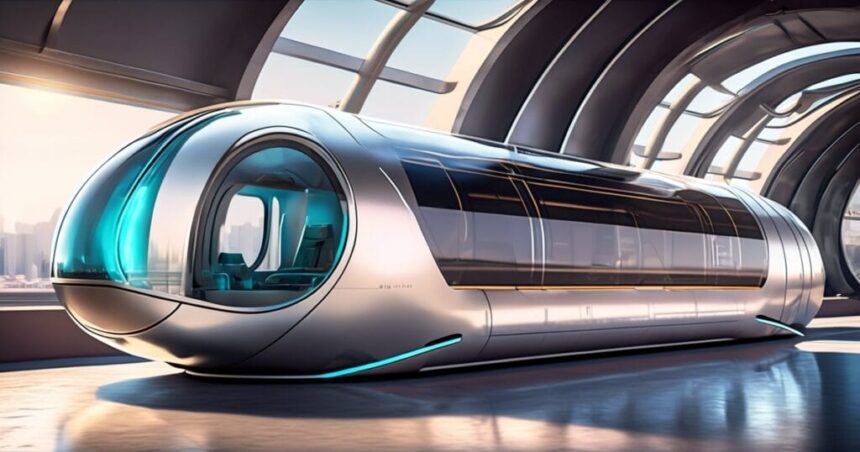- Key Takeaways
- Hyperloop Technology Explained
- Evolution of Hyperloop
- Global Hyperloop Developments
- Hyperloop’s Impact on Transportation
- Proposed Hyperloop Routes
- Challenges Facing Hyperloop
- Future of Hyperloop Technology
- Final Remarks
- Frequently Asked Questions
Are you looking for a transportation technology that can revolutionize our travel? Imagine reaching your destination at incredible speeds, bypassing traffic and congestion. What if I told you there’s a groundbreaking solution called hyperloop transportation technology that could make this a reality with high-speed travel time?
Hyperloop, a mode of transport, combines the speed of air travel with the efficiency of trains for passengers. Using magnetic levitation and low-pressure tubes, it propels passengers or cargo pods at high speeds through tunnels. With its potential to reach speeds over 700 miles per hour, the hyperloop has the power to transform long-distance travel.
Key Takeaways
- Hyperloop technology has the potential to revolutionize transportation by offering high-speed, energy-efficient, and sustainable travel options.
- To fully understand the concept of the Hyperloop, it is important to grasp its evolution, from the initial idea to the current global developments.
- The global Hyperloop landscape is rapidly expanding, with various countries and companies investing in developing and testing Hyperloop systems.
- Implementing Hyperloop technology could significantly impact transportation by reducing travel times, relieving congestion, and improving overall efficiency.
- Numerous proposed Hyperloop routes worldwide aim to connect major cities and regions, enhancing connectivity and facilitating economic growth.
- Despite its promising potential, Hyperloop faces several challenges, including regulatory hurdles, safety concerns, and the need for substantial infrastructure investments.
- The future of Hyperloop technology looks promising, with ongoing advancements and collaborations driving innovation and bringing us closer to a new era of transportation.
Hyperloop Technology Explained
Theoretical Basis
Hyperloop transportation technology is built on a solid theoretical basis. The hyperloop transport system takes advantage of reduced air resistance within low-pressure tubes, enabling passengers to travel at high speeds with minimal energy consumption. This concept draws inspiration from various sources, including pneumatic tube systems, high-speed trains, and aerospace engineering principles.
The hyperloop system utilizes either magnetic levitation (maglev) or air cushioning to achieve its incredible speeds. These technologies eliminate friction between the pod and the tube, allowing for efficient movement and high-speed transportation. Hyperloop capsules can reach astonishing velocities by reducing drag and minimizing energy loss due to friction.
Intelligent Systems
One of the key components of hyperloop technology is its incorporation of intelligent systems. These advanced algorithms optimize pod movement, traffic flow, and passenger safety throughout the network.
The intelligent systems continuously monitor speed, temperature, pressure, power consumption, and design to ensure smooth operation. By analyzing real-time data from sensors embedded in the infrastructure and pods themselves, these systems can make informed decisions to maintain optimal performance.
Moreover, these intelligent systems enable high-speed predictive maintenance by detecting potential faults before they cause disruptions or hazards. They also have emergency response capabilities that swiftly address unforeseen circumstances for enhanced safety and reliability.
Infrastructure Design
The design of a hyperloop system encompasses more than just the pods themselves; it includes an elaborate infrastructure that supports safe and efficient travel. The elevated or underground tubes, designed by Musk, provide a controlled environment for transporting passengers or cargo at high speeds.
In addition to the high-speed tubes, hyperloop infrastructure incorporates stations where passengers safely board and disembark from capsules. Loading mechanisms are designed for quick entry and exit while ensuring passenger comfort during their journey.
Furthermore, emergency exits are strategically placed along the route to guarantee swift evacuation if necessary. Power supply infrastructure ensures uninterrupted operations even in challenging conditions like extreme temperatures or weather events like earthquakes.
Evolution of Hyperloop
Vactrains Origin
The concept of vactrains, or vacuum trains, can be traced back to Robert H. Goddard’s proposal in 1904. These trains utilize low-pressure environments to reduce air resistance and enable high-speed travel. Vactrains can achieve faster speeds than traditional trains by removing most of the air from a tube.
Open-Source Contributions
Hyperloop development has seen significant contributions from open-source communities, fostering collaboration and innovation. Companies like SpaceX have organized global competitions, encouraging teams to design and build hyperloop prototypes. Through these initiatives, knowledge sharing within the Hyperloop community has been accelerated.
Open-source contributions have played a crucial role in advancing hyperloop technology. They have allowed researchers and engineers worldwide to collaborate on solving complex problems related to speed, safety, and scalability.
Technological Milestones
Several technological milestones have been achieved in the development of hyperloop transportation technology. Successful tests have demonstrated the feasibility of magnetic levitation, propulsion systems, tube construction, and pod designs.
Magnetic levitation is an essential component of hyperloop technology as it allows for frictionless movement by using magnetic fields to suspend pods above tracks. This breakthrough enables smooth acceleration and deceleration while minimizing energy consumption.
Furthermore, advancements in propulsion systems have made it possible for hyperloop pods to reach incredible speeds through various means, such as electric motors or compressed air systems.
Tube construction techniques continue to evolve with innovations to improve efficiency while ensuring structural integrity over long distances.
Ongoing research aims to refine these technologies further and address speed, safety, and scalability challenges. As more progress is made in these areas, we may soon witness a revolution in transportation that will transform how we travel across cities and countries.
Global Hyperloop Developments
Notable Companies
Various companies are actively developing hyperloop transportation technology and bringing it closer to reality. Examples of these companies include Virgin Hyperloop, Hyperloop Transportation Technologies (HTT), TransPod, and Arrivo. These companies are investing heavily in research, prototyping, and partnerships to advance the commercialization of hyperloop systems.
Virgin Hyperloop is one of the leading players in the field, with its successful test track located in Nevada. They have made significant progress in demonstrating the feasibility and safety of hyperloop technology through rigorous testing. Similarly, HTT has partnered with organizations worldwide to develop innovative solutions for hyperloop infrastructure and passenger experience.
These companies recognize that collaboration is key to achieving their goals. By partnering with governments, universities, and other private entities, they can leverage expertise from different domains such as engineering, materials science, and logistics to overcome technical challenges associated with hyperloop transportation.
Research Programs
In addition to private enterprises driving development efforts, numerous research programs worldwide focus on advancing hyperloop technology through scientific studies and experimentation. Universities collaborate extensively with industry partners to explore different aspects of hyperloop systems, such as materials science for lightweight construction or aerodynamics for reducing air resistance.
These research programs significantly expand our knowledge base about the hyperloop while driving innovation within this emerging field. Scientists can gain valuable insights into system performance under various conditions by conducting experiments at dedicated facilities like test tracks or using computer simulations based on real-world data inputs gathered during previous tests or operational runs.
International Projects
Hyperloops have gained traction globally as countries like the United States (US), the United Arab Emirates (UAE), India, and China continue exploring implementation possibilities. The UAE’s Dubai-Abu Dhabi project aims to reduce travel time between these two cities to 12 minutes only!
Hyperloop’s Impact on Transportation
Commutes and Commerce
Hyperloop transportation technology has the potential to revolutionize daily commutes by significantly reducing travel times between cities. With its high-speed capabilities, hyperloop services can transport passengers faster than traditional modes of transportation like trains or cars. This means that people could reach their destinations in a fraction of the time it currently takes.
Imagine living in a suburb outside a major city but being able to commute to work downtown in just minutes instead of hours. The hyperloop’s efficiency and speed would allow commuters to live farther away from city centers while maintaining quick access to employment opportunities. This enhanced connectivity between regions can facilitate economic integration and seamless movement of goods and services, boosting commerce and productivity.
Community Benefits
The benefits of hyperloop systems extend beyond individual commutes. By offering an alternative mode of transportation that is both fast and efficient, hyperloops have the potential to reduce traffic congestion on roads and highways. This vehicle reduction would ease congestion and improve air quality by decreasing harmful emissions.
Moreover, the improved connectivity provided by hyperloop networks can promote economic development within communities. Regions that were once isolated or underserved may now have access to new job opportunities due to increased mobility options offered by the hyperloop system. This increased accessibility can also help bridge social equity gaps, providing affordable transportation alternatives for underserved areas.
Sustainability Aspects
In addition to its impact on commuting and community development, hyperloop technology aligns with sustainability goals. One key aspect is its low-carbon footprint compared to other modes of transportation, such as airplanes or cars powered by fossil fuels.
Hyperloops use electric propulsion systems, often powered by renewable energy sources such as solar or wind energy. By utilizing these clean energy sources, they minimize greenhouse gas emissions associated with traditional forms of transport.
Proposed Hyperloop Routes
Domestic and International
Hyperloop technology has the potential to transform transportation both domestically and internationally. Domestically, hyperloop networks can connect cities within a country, providing a fast and efficient mode of transit for commuters and travelers. Imagine traveling from one city to another in minutes instead of hours.
Internationally, hyperloop systems have the power to revolutionize cross-border transportation, fostering global connectivity like never before. With hyperloop routes spanning countries, people can travel seamlessly between nations at unprecedented speeds. This could open up new trade, tourism, and cultural exchange opportunities.
For example, imagine traveling from Los Angeles to San Francisco in just 30 minutes or reaching London from Paris in under an hour. These are the kinds of possibilities that hyperloop technology offers internationally.
Economic Implications
The development and implementation of hyperloop technology can also have significant economic implications. The construction of hyperloop networks requires substantial investments, attracting funding from both the public and private sectors. This influx of capital supports infrastructure development and stimulates job growth in various industries such as engineering, manufacturing, construction, and operations.
Moreover, once operationalized, hyperloop networks can boost local economies by facilitating faster movement of goods and people. Reduced travel times lead to increased efficiency for businesses operating along these routes. This enhanced productivity can make regions served by hyperloops more competitive globally.
In addition to these economic benefits at a regional level, there are also broader advantages associated with reduced carbon emissions due to lower energy consumption compared to traditional modes of transportation like cars or airplanes.
Challenges Facing Hyperloop
Political Hurdles
Implementing hyperloop transportation technology faces several political hurdles that must be addressed. One major challenge is obtaining regulatory approvals from governments. Since hyperloop systems are a relatively new concept, there may not be existing regulations to govern their operations. Governments must establish frameworks and regulations to ensure the safe operation of hyperloop systems.
Another political hurdle is land acquisition. Building a hyperloop network requires acquiring large parcels of land, which can be complicated due to legal and ownership issues. Negotiating with landowners and addressing any concerns or disputes can delay the progress of implementing hyperloop technology.
Public acceptance is also an important aspect that needs consideration. Introducing a new mode of transportation like the hyperloop may face resistance from the public, who are accustomed to traditional modes such as trains or airplanes. Concerns about safety, potential disruptions to existing transportation networks, and unfamiliarity with the technology can all contribute to public skepticism.
Implementation Barriers
Implementing hyperloop technology on a large scale presents its own set of challenges. One significant barrier is the high upfront costs of building infrastructure for hyperloops. Constructing elevated tracks or tunnels requires substantial investment, making it necessary for stakeholders to secure funding sources.
Technological complexities also pose challenges during implementation. Developing advanced propulsion systems, designing efficient pods capable of carrying passengers at high speeds, and ensuring reliable power supply are just some examples of technological hurdles that must be overcome.
Addressing legal and regulatory requirements is another crucial aspect when implementing hyperloops on a larger scale. It involves navigating different jurisdictions’ laws regarding transportation infrastructure development and operation permits.
Collaboration between governments, private companies, and research institutions plays an essential role in overcoming these barriers effectively by combining expertise and resources towards advancing this transformative mode of transport.
Future of Hyperloop Technology
Advancements and Prospects
Ongoing advancements in materials science, propulsion systems, automation, and AI hold promise for further improving hyperloop technology. Researchers and engineers are continuously exploring new materials that can enhance structural integrity, reduce weight, and increase the energy efficiency of hyperloop capsules. For example, developing stronger, lighter carbon fiber composites could make the capsules more aerodynamic and efficient.
The prospects of achieving higher speeds, reducing costs, increasing passenger capacity, and expanding network coverage are also encouraging. With continued research, testing, and collaboration among industry experts, it is possible to overcome current limitations. Modern hyperloop systems could achieve unprecedented speeds by leveraging advanced propulsion technologies such as magnetic levitation (maglev) or vacuum tubes to eliminate air resistance.
Moreover, integrating automation technologies can streamline operations by minimizing human error and optimizing energy consumption. Artificial intelligence (AI) algorithms can be employed to monitor various aspects of the system in real time for proactive maintenance or troubleshooting purposes.
Regulatory Landscape
The regulatory landscape for hyperloop technology is evolving as governments worldwide work to establish guidelines for its safe operation. International organizations like the International Organization for Standardization (ISO) are actively developing standards specific to hyperloop systems to ensure interoperability between different networks.
However, there are several legal frameworks that governments need to address before widespread implementation becomes a reality. These include liability issues related to accidents or malfunctions within a hyperloop system, operator insurance requirements, safety certifications ensuring compliance with established standards, operational protocols defining emergency procedures, land acquisition processes, environmental impact assessments, zoning regulations, etc.
Navigating these complexities effectively while prioritizing safety measures will require close collaboration between government bodies responsible for transportation policies and regulations and private companies invested in developing this revolutionary mode of transportation.
Final Remarks
In conclusion, the development of hyperloop technology has the potential to revolutionize transportation as we know it. With its high-speed capabilities, energy efficiency, and reduced environmental impact, hyperloop systems offer a promising solution to address the growing challenges of urban congestion and long-distance travel. The global interest and investment in hyperloop projects indicate a strong belief in its viability and potential benefits.
We must continue supporting research and development in this field as we look towards the future. Governments, private companies, and individuals should collaborate to overcome hyperloop implementation challenges, such as regulatory hurdles and infrastructure requirements. Doing so can pave the way for a new era of transportation that is faster, more sustainable, and accessible to all.
So why wait? Join the conversation on hyperloop technology and be part of shaping the future of transportation!
Frequently Asked Questions
How does Hyperloop technology work?
Hyperloop technology works by using a system of tubes or tunnels to transport pods at high speeds. These pods are propelled through the tubes using magnetic levitation and air pressure, creating a near-vacuum environment that minimizes friction and allows for efficient travel.
What is the impact of Hyperloop on transportation?
Hyperloop has the potential to revolutionize transportation by significantly reducing travel times. With speeds reaching up to 700 mph, it could enable people to commute long distances in a fraction of the time it currently takes. This would enhance connectivity and reduce congestion on roads and airports.
Are there any proposed routes for Hyperloop?
Yes, there are several proposed routes for Hyperloop around the world. Some examples include Los Angeles to San Francisco in the United States, Mumbai to Pune in India, and Dubai to Abu Dhabi in the United Arab Emirates. These routes aim to connect major cities currently separated by long distances.
What challenges does Hyperloop face?
Hyperloop faces challenges, such as regulatory hurdles, securing funding, ensuring passenger safety during high-speed travel, and addressing the technical complexities of maintaining a low-pressure environment within the tubes. Overcoming these challenges will be crucial for successfully implementing this futuristic mode of transportation.
What is the future outlook for hyperloop technology?
The future looks promising for Hyperloop technology as more companies invest in its development worldwide. As advancements continue, we can expect improved efficiency, enhanced safety measures, increased route options, and potentially even intercontinental connections via underwater tunnels or hyperloops suspended above sea level. The possibilities seem limitless!





